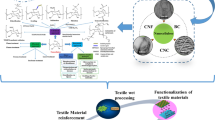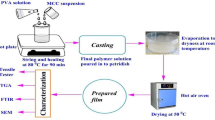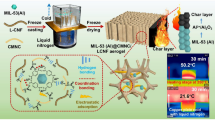Abstract
A biodegradable three-dimensional porous structure with thermal strength has drawn remarkable attention in solar thermal insulation. A strong hydrogen bonding caused the cellulose fibers to entangle and form a highly flexible and porous structure. In this study, monolithic aerogel was prepared from oil palm-based microfibril cellulose using an alkaline/urea solvent system and epichlorohydrin (ECH) as a cross-linker as a potential insulator for solar thermal energy application microfibril cellulose at various weight percentages (3%, 4%, and 5%) was dissolved in NaOH/urea/water and LiOH/urea/water solvent systems at 15 °C. The cellulosic solution was allowed to age for 24 h and subsequently gelled at 50 °C for 24 h to form a solid gel before washing. Following solvent exchange and subsequent freeze-drying, porous cellulose aerogel was produced. FESEM analysis reveals cellulose concentration influences the internal morphology of the aerogel, while thermal gravimetric analysis has recorded the aerogel to withstand thermal shock up to 266.8 °C. At 4% microfibril cellulose content, the monolithic aerogel exhibits a relatively homogenized pore with a honeycomb-like structure. It also demonstrated reasonably strong solar absorption capabilities within the NIR solar spectra region, confirming its potential for solar thermal extraction applications.
Graphical Abstract

Highlights
-
An environmentally conscious approach with utilization of oil palm cellulose microfiber producing exceptional structural and thermal properties of aerogel.
-
Monolithic cellulose-based aerogels’ entangled and highly flexible structure fosters a cohesive and porous network for enhanced thermal performance.
-
A remarkable three-dimensional porous structure with thermal strength, demonstrating an exceptional solar absorption capability within the near-infrared region, providing significant potential for efficient solar thermal energy applications.
-
The durability test confirms consistent near-infrared absorption over the aging process.










Similar content being viewed by others
References
Wang Q, Li J, Yang H et al. (2017) Performance analysis on a high-temperature solar evacuated receiver with an inner radiation shield. Energy 139:447–458. https://doi.org/10.1016/j.energy.2017.07.147
Chen X, Xia X-L, Yan X-W, Sun C (2017) Heat transfer analysis of a volumetric solar receiver with composite porous structure. Energy Convers Manag 136:262–269. https://doi.org/10.1016/j.enconman.2017.01.018
Sopian K, Supranto, Daud WR et al. (1999) Thermal performance of the double-pass solar collector with and without porous media. Renew Energy 18:557–564. https://doi.org/10.1016/S0960-1481(99)00007-5
Yashim MM, Sainorudin MH, Mohammad M et al. (2021) Recent advances on lightweight aerogel as a porous receiver layer for solar thermal technology application. Sol Energy Mater Sol Cells 228:111131. https://doi.org/10.1016/j.solmat.2021.111131
Oliveira FAC, Fernandes JC, Galindo J et al. (2019) Thermal resistance of solar volumetric absorbers made of mullite, brown alumina and ceria foams under concentrated solar radiation. Sol Energy Mater Sol Cells 194:121–129. https://doi.org/10.1016/j.solmat.2019.02.008
Chen X, Xia X-L, Meng X-L, Dong X-H (2015) Thermal performance analysis on a volumetric solar receiver with double-layer ceramic foam. Energy Convers Manag 97:282–289. https://doi.org/10.1016/j.enconman.2015.03.066
Zheng X, Gao X, Huang Z et al. (2021) Form-stable paraffin/graphene aerogel/copper foam composite phase change material for solar energy conversion and storage. Sol Energy Mater Sol Cells 226:111083. https://doi.org/10.1016/j.solmat.2021.111083
Wu L, Zhao B, Ao X et al. (2021) Performance analysis of the aerogel-based PV/T collector: a numerical study. Sol Energy 228:339–348. https://doi.org/10.1016/j.solener.2021.09.077
Zhao L, Bhatia B, Yang S et al. (2019) Harnessing heat beyond 200 °C from unconcentrated sunlight with nonevacuated transparent aerogels. ACS Nano 13:7508–7516. https://doi.org/10.1021/acsnano.9b02976
Günay AA, Kim H, Nagarajan N et al. (2018) Optically transparent thermally insulating silica aerogels for solar thermal insulation. ACS Appl Mater Interfaces 10:12603–12611. https://doi.org/10.1021/acsami.7b18856
Lao X, Xu X, Wu J, Xu X (2017) High-temperature alloy/honeycomb ceramic composite materials for solar thermal storage applications: preparation and stability evaluation. Ceram Int 43:4583–4593. https://doi.org/10.1016/j.ceramint.2016.12.119
Zhang Z, Mu P, He J et al. (2019) Facile and scalable fabrication of surface-modified sponge for efficient solar steam generation. ChemSusChem 12:426–433. https://doi.org/10.1002/cssc.201802406
Li Y, Samad YA, Polychronopoulou K et al. (2014) From biomass to high performance solar-thermal and electric-thermal energy conversion and storage materials. J Mater Chem A 2:7759–7765. https://doi.org/10.1039/c4ta00839a
Storer DP, Phelps JL, Wu X, et al (2020) Graphene and rice-straw-fiber-based 3D photothermal aerogels for highly efficient solar evaporation. ACS Appl Mater Interfaces. https://doi.org/10.1021/acsami.0c01707
O’sullvian AC (1997) Cellulose: the structure slowly unravels. Cellulose 4:173–207
Qiu X, Hu S (2013) “Smart” materials based on cellulose: a review of the preparations, properties, and applications. Materials 6:738–781. https://doi.org/10.3390/ma6030738
He M, Alam MK, Liu H et al. (2021) Textile waste derived cellulose based composite aerogel for efficient solar steam generation. Compos Commun 28:100936. https://doi.org/10.1016/j.coco.2021.100936
Gupta P, Singh B, Agrawal AK, Maji PK (2018) Low density and high strength nanofibrillated cellulose aerogel for thermal insulation application. Mater Des 158:224–236. https://doi.org/10.1016/j.matdes.2018.08.031
Jiménez-Saelices C, Seantier B, Cathala B, Grohens Y (2017) Spray freeze-dried nanofibrillated cellulose aerogels with thermal superinsulating properties. Carbohydr Polym 157:105–113. https://doi.org/10.1016/j.carbpol.2016.09.068
Jiang F, Liu H, Li Y et al. (2018) Lightweight, mesoporous, and highly absorptive all-nanofiber aerogel for efficient solar steam generation. ACS Appl Mater Interfaces 10:1104–1112. https://doi.org/10.1021/acsami.7b15125
Medronho B, Lindman B (2014) Competing forces during cellulose dissolution: from solvents to mechanisms. Curr Opin Colloid Interface Sci 19:32–40. https://doi.org/10.1016/j.cocis.2013.12.001
Budtova T, Navard P (2016) Cellulose in NaOH–water based solvents: a review. Cellulose 23:5–55. https://doi.org/10.1007/s10570-015-0779-8
Sen S, Martin JD, Argyropoulos DS (2013) Review of cellulose non-derivatizing solvent interactions with emphasis on activity in inorganic molten salt hydrates. ACS Sustain Chem Eng 1:858–870. https://doi.org/10.1021/sc400085a
Huang K, Wang Y (2022) Recent applications of regenerated cellulose films and hydrogels in food packaging. Curr Opin Food Sci 43:7–17. https://doi.org/10.1016/j.cofs.2021.09.003
Jin H, Zha C, Gu L (2007) Direct dissolution of cellulose in NaOH/thiourea/urea aqueous solution. Carbohydr Res https://doi.org/10.1016/j.carres.2006.12.023
Cai J, Kimura S, Wada M et al. (2008) Cellulose aerogels from aqueous alkali hydroxide–urea solution. ChemSusChem 1:149–154. https://doi.org/10.1002/cssc.200700039
Cai J, Zhang L, Zhou J, et al (2004) Novel fibers prepared from cellulose in NaOH/urea aqueous solution. Macromol Rapid Commun https://doi.org/10.1002/marc.200400172
Wang S, Lu A, Zhang L (2016) Recent advances in regenerated cellulose materials. Prog Polym Sci 53:169–206. https://doi.org/10.1016/j.progpolymsci.2015.07.003
Jiang F, Hsieh Y Lo (2014) Super water absorbing and shape memory nanocellulose aerogels from TEMPO-oxidized cellulose nanofibrils via cyclic freezing-thawing. J Mater Chem A. https://doi.org/10.1039/c3ta13629a
Tran DT, Nguyen ST, Do ND, et al (2020) Green aerogels from rice straw for thermal, acoustic insulation and oil spill cleaning applications. Mater Chem Phys. https://doi.org/10.1016/j.matchemphys.2020.123363
Lin J, Yu L, Tian F, et al (2014) Cellulose nanofibrils aerogels generated from jute fibers. Carbohydr Polym. https://doi.org/10.1016/j.carbpol.2014.03.045
Do NHN, Luu TP, Thai QB, et al (2020) Advanced fabrication and application of pineapple aerogels from agricultural waste. Mater Technol. https://doi.org/10.1080/10667857.2019.1688537
Nguyen TH, Nguyen VV, Nguyen NT, et al (2022) Preparation, characterization and CDI application of KOH-activated porous waste-corn-stalk-based carbon aerogel. J Porous Mater. https://doi.org/10.1007/s10934-022-01411-1
Wang W, Yang D, Mou L et al. (2022) Remodeling of waste corn stalks into renewable, compressible and hydrophobic biomass-based aerogel for efficient and selective oil/organic solvent absorption. Colloids Surf A: Physicochem Eng Asp 645:128940. https://doi.org/10.1016/j.colsurfa.2022.128940
Onoja E, Chandren S, Abdul Razak FI et al. (2019) Oil palm (Elaeis guineensis) biomass in Malaysia: the present and future prospects. Waste Biomass- Valoriz 10:2099–2117. https://doi.org/10.1007/s12649-018-0258-1
Subramaniam V, Loh SK, Aziz AA (2021) GHG analysis of the production of crude palm oil considering the conversion of agricultural wastes to by-products. Sustain Prod Consum. https://doi.org/10.1016/j.spc.2021.09.004
Burhani D, Septevani AA, Setiawan R, et al (2021) Self-assembled behavior of ultralightweight aerogel from a mixture of cnc/cnf from oil palm empty fruit bunches. Polymers. https://doi.org/10.3390/polym13162649
Yahya EB, Abdul Khalil HPS, Ahmad MI, et al (2023) Cleaner approach of preparing antibacterial bioaerogel scaffolds using oil palm waste nanocellulose. Ind Crops Prod. https://doi.org/10.1016/j.indcrop.2022.115897
Ago M, Ferrer A, Rojas OJ (2016) Starch-based biofoams reinforced with lignocellulose nanofibrils from residual palm empty fruit bunches: water sorption and mechanical strength. ACS Sustain Chem Eng. https://doi.org/10.1021/acssuschemeng.6b01279
Mohd NH, Kargazadeh H, Miyamoto M et al. (2021) Aminosilanes grafted nanocrystalline cellulose from oil palm empty fruit bunch aerogel for carbon dioxide capture. J Mater Res Technol 13:2287–2296. https://doi.org/10.1016/j.jmrt.2021.06.018
Yashim MM, Mohammad M, Asim N et al. (2021) Characterisation of microfibrils cellulose isolated from oil palm frond using high-intensity ultrasonication. IOP Conf Ser: Mater Sci Eng 1176:012004. https://doi.org/10.1088/1757-899x/1176/1/012004
Kumneadklang S, O-Thong S, Larpkiattaworn S (2019) Characterization of cellulose fiber isolated from oil palm frond biomass. Mater Today: Proc 17:1995–2001. https://doi.org/10.1016/j.matpr.2019.06.247
Cai J, Zhang L (2005) Rapid dissolution of cellulose in LiOH/Urea and NaOH/urea aqueous solutions. Macromol Biosci 5:539–548. https://doi.org/10.1002/mabi.200400222
Liu H, Tian X, Xiang X, Chen S (2022) Preparation of carboxymethyl cellulose/graphene composite aerogel beads and their adsorption for methylene blue. Int J Biol Macromol 202:632–643. https://doi.org/10.1016/j.ijbiomac.2022.01.052
Dilamian M, Noroozi B (2021) Rice straw agri-waste for water pollutant adsorption: relevant mesoporous super hydrophobic cellulose aerogel. Carbohydr Polym 251:117016. https://doi.org/10.1016/j.carbpol.2020.117016
Brunauer S, Emmett PH, Teller E (1938) Adsorption of gases in multimolecular layers. J Am Chem Soc. https://doi.org/10.1021/ja01269a023
Barrett EP, Joyner LG, Halenda PP (1951) The determination of pore volume and area distributions in porous substances. I. Computations from nitrogen isotherms. J Am Chem Soc. https://doi.org/10.1021/ja01145a126
Park S, Baker JO, Himmel ME et al. (2010) Cellulose crystallinity index: measurement techniques and their impact on interpreting cellulase performance. Biotechnol Biofuels 3:10. https://doi.org/10.1186/1754-6834-3-10
Amiralian N, Annamalai PK, Memmott P, Martin DJ (2015) Isolation of cellulose nanofibrils from Triodia pungens via different mechanical methods. Cellulose 22:2483–2498. https://doi.org/10.1007/s10570-015-0688-x
Sofla MRK, Brown RJ, Tsuzuki T, Rainey TJ (2016) A comparison of cellulose nanocrystals and cellulose nanofibres extracted from bagasse using acid and ball milling methods. Adv Nat Sci: Nanosci Nanotechnol 7:035004. https://doi.org/10.1088/2043-6262/7/3/035004
Gupta V, Ramakanth D, Verma C, et al (2021) Isolation and characterization of cellulose nanocrystals from amla (Phyllanthus emblica) pomace. Biomass Convers Biorefin https://doi.org/10.1007/s13399-021-01852-9
Chowdhury ZZ, Hamid SBA (2016) Preparation and characterization of nanocrystalline cellulose using ultrasonication combined with a microwave-assisted pretreatment process. BioResources 11. https://doi.org/10.15376/biores.11.2.3397-3415
Gatot SH (2012) Synthesis and characterization of sodium carboxymethylcellulose from pod husk of Cacao (Theobroma cacao L.). Afr J Food Sci 6:180–185. https://doi.org/10.5897/AJFS12.020
Li H, Zhang H, Xiong L et al. (2019) Isolation of cellulose from wheat straw and its utilization for the preparation of carboxymethyl cellulose. Fibers Polym 20:975–981. https://doi.org/10.1007/s12221-019-7717-6
Thapliyal PC, Singh K (2014) Aerogels as promising thermal insulating materials: an overview. 2014
Li R, Wang S, Lu A, Zhang L (2015) Dissolution of cellulose from different sources in an NaOH/urea aqueous system at low temperature. Cellulose. https://doi.org/10.1007/s10570-014-0542-6
Shi JJ, Lu L Bin, Zhang JY (2013) An environment-friendly thermal insulation material from porous cellulose aerogel. Adv Mater Res 773:487–491. https://doi.org/10.4028/www.scientific.net/AMR.773.487
Zhou J, Chang C, Zhang R, Zhang L (2007) Hydrogels prepared from unsubstituted cellulose in NaOH/urea aqueous solution. Macromol Biosci 7:804–809. https://doi.org/10.1002/mabi.200700007
Wan C, Lu Y, Jiao Y et al. (2015) Cellulose aerogels from cellulose–NaOH/PEG solution and comparison with different cellulose contents. Mater Sci Technol 31:1096–1102. https://doi.org/10.1179/1743284714Y.0000000677
Van Nguyen TT, Tri N, Tran BA et al. (2021) Synthesis, characteristics, oil adsorption, and thermal insulation performance of cellulosic aerogel derived from water hyacinth. ACS Omega 6:26130–26139. https://doi.org/10.1021/acsomega.1c03137
Zhao Y, Zhong K, Liu W, et al (2020) Preparation and oil adsorption properties of hydrophobic microcrystalline cellulose aerogel. Cellulose. https://doi.org/10.1007/s10570-020-03309-0
Sing KSW(1985) Reporting physisorption data for gas/solid systems with special reference to the determination of surface area and porosity (Recommendations 1984) 57:603–619 Pure Appl Chem 57:603–19. https://doi.org/10.1351/pac198557040603
Gao H, Bo L, Liu P et al. (2019) Ambient pressure dried flexible silica aerogel for construction of monolithic shape-stabilized phase change materials. Sol Energy Mater Sol Cells 201:110122. https://doi.org/10.1016/j.solmat.2019.110122
Kamal Mohamed SM, Ganesan K, Milow B, Ratke L (2015) The effect of zinc oxide (ZnO) addition on the physical and morphological properties of cellulose aerogel beads. RSC Adv 5:90193–90201. https://doi.org/10.1039/C5RA17366C
Salleh KM, Zakaria S, Sajab MS et al. (2019) Superabsorbent hydrogel from oil palm empty fruit bunch cellulose and sodium carboxymethylcellulose. Int J Biol Macromol 131:50–59. https://doi.org/10.1016/j.ijbiomac.2019.03.028
Granqvist CG, Niklasson GA (2018) Solar energy materials for thermal applications: a primer. Sol Energy Mater Sol Cells 180:213–226. https://doi.org/10.1016/j.solmat.2018.02.004
Tsao Y-C, Søndergaard T, Skovsen E, et al (2013) Pore size dependence of diffuse light scattering from anodized aluminum solar cell backside reflectors. Optics Express. https://doi.org/10.1364/oe.21.000a84
Gamage S, Banerjee D, Alam MM, et al (2021) Reflective and transparent cellulose-based passive radiative coolers. Cellulose. https://doi.org/10.1007/s10570-021-04112-1
Muscio A (2018) The solar reflectance index as a tool to forecast the heat released to the urban environment: potentiality and assessment issues. Climate 6:12. https://doi.org/10.3390/cli6010012
Chen M, Pang D, Yan H (2022) Highly solar reflectance and infrared transparent porous coating for non-contact heat dissipations. iScience 25:104726. https://doi.org/10.1016/j.isci.2022.104726
Berardi U, Nosrati RH (2018) Long-term thermal conductivity of aerogel-enhanced insulating materials under different laboratory aging conditions. Energy. https://doi.org/10.1016/j.energy.2018.01.053
Chal B, Foray G, Yrieix B, et al (2018) Durability of silica aerogels dedicated to superinsulation measured under hygrothermal conditions. Microporous Mesoporous Mater. https://doi.org/10.1016/j.micromeso.2018.05.047
Maia J, Pedroso M, Ramos NMM, et al (2021) Durability of a new aerogel cement-based rendering system under distinct accelerated aging conditions. Materials. https://doi.org/10.3390/ma14185413
Acknowledgements
The authors also thank the Research Laboratory staff of the University of Technology MARA, Bukit Besi Campus, for assisting with the laboratory work.
Funding
Funding from the Fundamental Research Grant Scheme (FRGS/1/2019/TK10/UKM/02/1) by the Ministry of Higher Education of Malaysia is gratefully acknowledged for the completion of our original work.
Author information
Authors and Affiliations
Contributions
MMY: Methodology, Investigation, Characterization, Formal analysis, Writing—original draft. MM: Conceptualization, Visualization, Writing—review & editing NA: Data curation, Validation, Writing—review & editing. AF: Funding acquisition, Project administration.
Corresponding author
Ethics declarations
Conflict of interest
The authors declare no competing interests.
Additional information
Publisher’s note Springer Nature remains neutral with regard to jurisdictional claims in published maps and institutional affiliations.
Rights and permissions
Springer Nature or its licensor (e.g. a society or other partner) holds exclusive rights to this article under a publishing agreement with the author(s) or other rightsholder(s); author self-archiving of the accepted manuscript version of this article is solely governed by the terms of such publishing agreement and applicable law.
About this article
Cite this article
Mat Yashim, M., Mohammad, M., Asim, N. et al. Structure and properties of monolithic cellulose aerogels prepared from oil palm cellulose microfiber (OPMFC) using alkaline/urea solvent system potentially for solar thermal applications. J Sol-Gel Sci Technol 108, 47–59 (2023). https://doi.org/10.1007/s10971-023-06189-5
Received:
Accepted:
Published:
Issue Date:
DOI: https://doi.org/10.1007/s10971-023-06189-5




